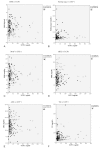Serum levels of uncoupling proteins in patients with differential insulin resistance: A community-based cohort study
- PMID: 28984759
- PMCID: PMC5737995
- DOI: 10.1097/MD.0000000000008053
Serum levels of uncoupling proteins in patients with differential insulin resistance: A community-based cohort study
Abstract
The uncoupling protein (UCP) belongs to a family of energy-dissipating proteins in mitochondria. Increasing evidences have indicated that UCPs have immense impact on glucose homeostasis and are key proteins in metabolic syndrome. For applying the findings to clinical practice, we designed a study to explore the association between serum UCPs 1-3 and insulin resistance. This investigation prospectively recorded demographical parameter and collected blood samples of 1071 participants from 4 districts in Northeastern Taiwan during the period from August 2013 to July 2014. Propensity score matching by age and sex in patients with top and bottom third homeostasis model assessment of insulin resistance (HOMA-IR) levels was performed, and 326 subjects were enrolled for further studies. The mean age of the patients was 59.4 years and the majority of them (65.5%) were females. The prevalence of metabolic syndrome was 35.5%. Our results demonstrated that serum UCPs 1-3 were significantly associated with differences in HOMA-IR levels. Multiple logistic regression analysis indicated that low UCP 1 and features of metabolic syndrome, namely hypertension, diabetes, body mass index, and high-density lipoprotein, were independent determinants for high HOMA-IR levels. We thus determined that low serum UCP 1 is a predictor for high resistance to insulin.
Conflict of interest statement
The authors have no conflicts of interest to disclose.
Figures


Similar articles
-
Association between high-fasting insulin levels and metabolic syndrome in non-diabetic middle-aged and elderly populations: a community-based study in Taiwan.BMJ Open. 2018 May 3;8(5):e016554. doi: 10.1136/bmjopen-2017-016554. BMJ Open. 2018. PMID: 29724734 Free PMC article.
-
Can Visceral Adiposity Index Serve as a Simple Tool for Identifying Individuals with Insulin Resistance in Daily Clinical Practice?Medicina (Kaunas). 2019 Aug 29;55(9):545. doi: 10.3390/medicina55090545. Medicina (Kaunas). 2019. PMID: 31470593 Free PMC article.
-
High HOMA-IR Index in Healthcare Shift Workers.Medicina (Kaunas). 2019 May 22;55(5):186. doi: 10.3390/medicina55050186. Medicina (Kaunas). 2019. PMID: 31121834 Free PMC article.
-
Features of the metabolic syndrome in late adolescence are associated with impaired testicular function at 20 years of age.Hum Reprod. 2019 Mar 1;34(3):389-402. doi: 10.1093/humrep/dey371. Hum Reprod. 2019. PMID: 30576537
-
Severity Grade Assessment Classifications for Both Insulin Resistance Syndrome and Status of Pancreatic Beta Cell Function in Clinical Practice Using Homeostasis Model Assessment Method Indices.Can J Diabetes. 2020 Oct;44(7):663-669. doi: 10.1016/j.jcjd.2020.02.003. Epub 2020 Feb 16. Can J Diabetes. 2020. PMID: 32360150 Review. No abstract available.
Cited by
-
UCP2 as a Potential Biomarker for Adjunctive Metabolic Therapies in Tumor Management.Front Oncol. 2021 Mar 8;11:640720. doi: 10.3389/fonc.2021.640720. eCollection 2021. Front Oncol. 2021. PMID: 33763373 Free PMC article. Review.
-
Mitochondrial dysfunction and pancreatic islet β-cell failure (Review).Exp Ther Med. 2020 Dec;20(6):266. doi: 10.3892/etm.2020.9396. Epub 2020 Oct 27. Exp Ther Med. 2020. PMID: 33199991 Free PMC article. Review.
-
Sex Differences in the Relationship between Excessive Alcohol Consumption and Metabolic Abnormalities: A Community-Based Study in Taiwan.Nutrients. 2022 Jul 19;14(14):2957. doi: 10.3390/nu14142957. Nutrients. 2022. PMID: 35889913 Free PMC article.
-
Association of 45-bp ins/del polymorphism of uncoupling protein 2 (UCP2) and susceptibility to nonalcoholic fatty liver and type 2 diabetes mellitus in North-west of Iran.BMC Res Notes. 2021 May 6;14(1):169. doi: 10.1186/s13104-021-05586-9. BMC Res Notes. 2021. PMID: 33957975 Free PMC article.
References
-
- Echtay KS, Brand MD. 4-hydroxy-2-nonenal and uncoupling proteins: an approach for regulation of mitochondrial ROS production. Redox Rep 2013;12:26–9. - PubMed
-
- Boss O, Hagen T, Lowell BB. Uncoupling proteins 2 and 3: potential regulators of mitochondrial energy metabolism. Diabetes 2000;49:143–56. - PubMed
-
- Erlanson-Albertsson C. The role of uncoupling proteins in the regulation of metabolism. Acta Physiol Scand 2003;178:405–12. - PubMed
MeSH terms
Substances
LinkOut - more resources
Full Text Sources
Other Literature Sources
Medical

